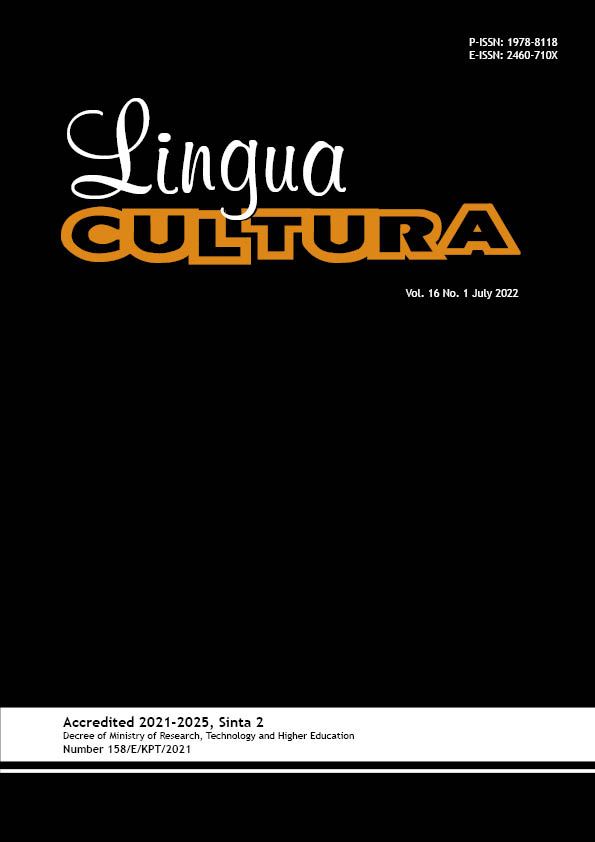Subtitling and Dubbing of Idiomatic Expressions in the American TV Series WandaVision
DOI:
https://doi.org/10.21512/lc.v16i1.7806Keywords:
subtitling, dubbing, idiomatic expression, audiovisual translationAbstract
The research aimed to find out the translation strategies applied in the subtitling and the dubbing of idiomatic expressions in the television series WandaVision (2021). Moreover, the research also aimed to reveal whether the subtitling and the dubbing of the idiomatic expressions are source language-oriented or target languageoriented. The descriptive qualitative approach was applied in the research. The data were analyzed using the taxonomy for rendering extralinguistic cultural references in subtitling proposed by Pedersen. The taxonomy was used to analyze the data since it was specifically designed for subtitling and audiovisual translation. The results show that there are various strategies applied in subtitling and dubbing. In subtitling, the translation strategies applied are substitution, direct translation, generalization, and the combination of substitution and omission. The translation strategies applied in the subtitling are related to spatial and temporal constraints. As a comparison, the translation strategies applied in dubbing are substitution, direct translation, generalization, and the combination of substitution and specification. The strategies are applied based on the consideration that spoken language features should be included in the dubbing. Based on the translation strategies applied, it can be concluded that both the subtitling and the dubbing are target language-oriented.
References
Abdelaal, N. M. (2019). Subtitling of culture-bound terms: Strategies and quality assessment. Heliyon, 5(4), 1-27. https://doi.org/10.1016/j.heliyon.2019.e01411.
Baños, R. (2021). Creating credible and natural-sounding dialogs in dubbing: Can it be taught? Interpreter and Translator Trainer, 15(1), 13-33. https://doi.org/10.1080/1750399X.2021.1880262.
Bosseaux, C. (2019). Investigating dubbing: Learning from the past, looking to the future. In L. Pérez-González (Ed.), The Routledge Handbook of Audiovisual Translation (pp. 48-63). New York: Routledge.
Božović, P. (2019). How should culture be rendered in subtitling and dubbing? Babel, International Journal of Translation, 65(1), 81-95. https://doi.org/10.1075/babel.00082.boz.
Brezolin, A., & Medeiros, F. D. (2021). Bad words in the good place: Analyzing the euphemistic function of wordplays in subtitling and dubbing – A case of English and Portuguese language pair. European Journal of Literature, Language and Linguistics Studies, 5(1), 14-31. https://doi.org/10.46827/ejlll.v5i1.250.
Forutan, M. K., & Modarresi, G. (2018). Translation of cultural taboos in Hollywood movies in professional dubbing and non-professional subtitling. Journal of Intercultural Communication Research, 47(6), 454-473. https://doi.org/10.1080/17475759.2018.1480516.
Hammou, S. B. (2020). Shift of oral and written language features in audio-visual translation : A case study of subtitling and dubbing of the American tv show “Prison Breakâ€. International Journal of English Language Studies (IJELS), 2(2), 30-45.
Kusuma, J. J., & Rini, J. E. (2020). Translation procedures of the Indonesian subtitles of English idiomatic expressions found in Inside Out. Kata Kita: Journal of Language, Literature, and Teaching, 8(1), 1-8. https://doi.org/10.9744/katakita.8.1.1-8.
Manipuspika, Y. S., & Winzami, D. R. J. (2021). Translation of idioms: How they are reflected in movie subtitling. Arab World English Journal for Translation and Literary Studies, 5(1), 113-125. https://doi.org/http://dx.doi.org/10.24093/awejtls/vol5no1.8.
Miggiani, G. S. (2021). Exploring applied strategies for English-language dubbing. Journal of Audiovisual Translation, 4(1), 137-156. https://doi.org/10.47476/jat.v4i1.2021. 166.
Pedersen, J. (2011). Subtitling norms for translation. Amsterdam: John Benjamins Publishing Company.
Perego, E., Del Missier, F., & Stragà , M. (2018). Dubbing vs. subtitling. Target: International Journal of Translation Studies, 30(1), 137-157. https://doi.org/10.1075/target.16083.per.
Puspitasari, M. S., Tabiati, S. E., & Junining, E. (2020). Translation in movie subtitles: Foreignization and domestication. Lensa: Kajian Kebahasaan, Kesusastraan, dan Budaya, 10(1), 1-15. https://doi.org/10.26714/lensa.10.1.2020.1-15.
Putri, F., & Wijaya, A. (2021). The comparison of strategies used in translating idiomatic expressions in a fansub and the official subtitle of Game Night movie (2018). International Review of Humanities Studies, 6(2), 708-725. https://doi.org/10.7454/irhs.v6i2.348.
Tyasrinestu, P., & Ardi, P. (2020). Idiomatic expressions and their Indonesian subtitles in the Good Doctor tv series. LLT Journal: A Journal on Language and Language Teaching, 23(1), 37-57. https://doi.org/10.24071/llt.v23i1.2360.
Downloads
Published
How to Cite
Issue
Section
License
Copyright (c) 2022 I Gusti Ayu Mahatma Agung

This work is licensed under a Creative Commons Attribution-ShareAlike 4.0 International License.
Authors who publish with this journal agree to the following terms:
a. Authors retain copyright and grant the journal right of first publication with the work simultaneously licensed under a Creative Commons Attribution License - Share Alike that allows others to share the work with an acknowledgment of the work's authorship and initial publication in this journal.
b. Authors are able to enter into separate, additional contractual arrangements for the non-exclusive distribution of the journal's published version of the work (e.g., post it to an institutional repository or publish it in a book), with an acknowledgment of its initial publication in this journal.
c. Authors are permitted and encouraged to post their work online (e.g., in institutional repositories or on their website) prior to and during the submission process, as it can lead to productive exchanges, as well as earlier and greater citation of published work.
USER RIGHTS
All articles published Open Access will be immediately and permanently free for everyone to read and download. We are continuously working with our author communities to select the best choice of license options, currently being defined for this journal as follows: Creative Commons Attribution-Share Alike (CC BY-SA)


















